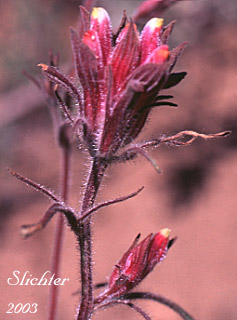 The photo
at right shows a close-up of the inflorescence of Clustered Bird's Beak as seen
at the junction of forest roads 2100 & 2008 on Table Mt., Wenatchee N.F.........July
25, 1996.
The photo
at right shows a close-up of the inflorescence of Clustered Bird's Beak as seen
at the junction of forest roads 2100 & 2008 on Table Mt., Wenatchee N.F.........July
25, 1996.
Clustered bird's beak is a wildflower from 10 to 60 cm in height. It is somewhat branched, with the leaves primarily on the stems. Individual leaves are long and thin with pointed tips, appearing like three-pronged forks. The margins of "tines" are entire.
The inflorescences are found at the tip of the main stem and at the tips of the branches. Individual inflorescences are usually two to five flowered. The calyx tends to be purplish as is the corolla. The lower calyx is almost as long as the corolla (10 to 15 mm in length), while the upper calyx is somewhat shorter and tipped with two teeth.
Clustered bird's beak is found on open slopes and in dry woods from the lowlands to moderate elevations in the mountains. It is often found in sagebrush.
Clustered bird's beak is found from Kittitas County, Washington east to southwestern Montana and south to northeastern Nevada and northeastern California.
In the Columbia River Gorge, it may be found at an elevation of 3900' atop Monte Carlo.